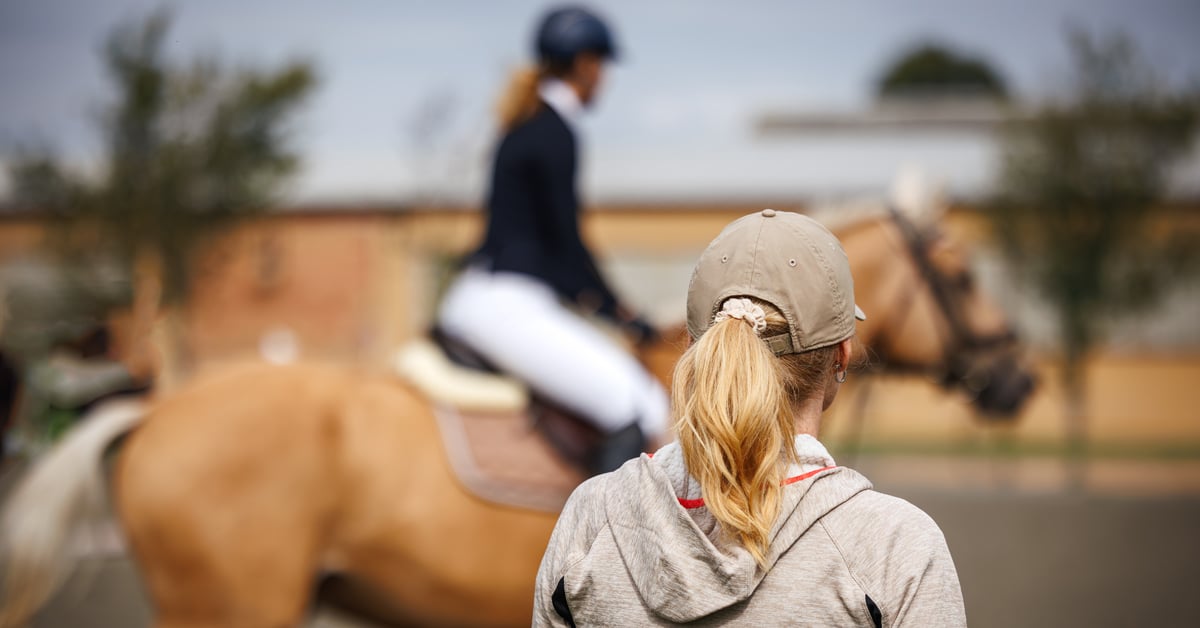Virtual coaching allows coaches to teach lessons remotely and offer long-distance lessons to their clients through the use of high- or low-tech devices. Virtual coaching can either be done with the use of pre-recorded rides or through real-time or livestream rides. Although virtual coaching can be done anytime and anywhere, it can be particularly useful during this Covid-19 pandemic when many coaches are being advised to suspend in-person lessons.
In order to offer virtual coaching, the rider will need to find a way to record their ride. There are a variety of options that can range from free to costing hundreds of dollars. The most basic option is to have someone record the ride with the use of a video camera, smart phone, or iPad. This allows the rider’s training session to be recorded and then uploaded to a platform such as YouTube or can even be uploaded to file sharing software such as Google Drive, Dropbox, or Microsoft OneDrive.
Once uploaded, the riding instructor is able to review the ride and offer constructive criticism back to the rider. This can easily be accomplished by sending a feedback email to the rider, or can be done through the use of Skype, Zoom, or FaceTime. Another option for reviewing video with the rider is using an online platform called Coach’s Eye. This service allows both the coach and rider to analyze video at the same time and includes features such as slow motion playback and telestration (ability to draw directly on the video to highlight features of the ride). The subscription fee for this service is $120 US per year.
Auto-Follow Cameras
In order to take part in live stream coaching, an internet connection is required. A low-tech free option is streaming the ride through the use of Skype. Although this option is doable, it is not recommended as the overall quality of the video feed may not be adequate. As a result, the coach may be limited in what they can see at their end.
For high-tech live streaming, a robotic camera or auto-follow camera is required. There are currently three on the market that are promoted to the equine industry – Soloshot3, PIXIO, and PIXEM. All three are used with a wristband that helps the camera track and focus on the rider through the use of auto-zoom.
Soloshot3 is a ‘robot cameraman’ that automatically tracks the action from up to 2,000 feet away with a built-in camera. The only downside to Soloshot3 is that it is for outdoor use only, so will not work in an indoor arena. Retail price ranges from $800-1,000 US.
PIXIO and PIXEM have both been developed by a company called Move ‘N See. They are considered superior products to the Soloshot3 as they use three mini-beacons to help the camera triangulate and provide better focus. The only downside is that the PIXIO and PIXEM do not have a built-in camera. The PIXIO is for use with a third-party camera such as Sony or Canon, or can be used with an action camera such as GoPro. PIXEM is specifically designed to be used with a smartphone or iPad. The one advantage over Soloshot3 is that PIXIO and PIXEM can be used indoors. These two products have a range up to 330 feet and retail for $800 US.
PIXIO is the official supplier to the FEI and US Equestrian. US Equestrian members receive a 10% discount on PIXIO/PIXEM equipment and a complimentary six-month live lesson subscription with Move N’ See.
All three auto-follow cameras include a free app that allows a user at the other end to watch a livestream of the video. Move ‘N See has gone one step further and designed TV.Movensee.com and CoachFinder.Movensee.com (designed specifically for the equine industry) which allows coaches to teach the rider during the livestream through the use of microphones. This means that a clinician in California could teach an entire dressage clinic in Toronto through the use of an auto-follow camera and microphone. Coach Finder is a service that allows a rider to find a coach anywhere in the world. This service is free for the coach and costs $29 US per month for the rider.
Other Uses for Auto-Follow Cameras

Liability
When business owners are adding services, they must consult with their business partners, including their insurance company and professional associations, to ensure they understand the parameters in which they work and provide services. Not all coaches’ insurance covers livestream virtual coaching, so it is important to check with your insurance provider before offering these services. While some insurers do cover real-time/livestream lessons and coaching, others will only cover reviewing pre-recorded video and offering critiques.
There are also safety issues to consider. Know the limitations of your students; virtual coaching is probably not suitable for beginner riders, for example, and make sure junior riders are always supervised by an adult.
*****
Join Tracy Dopko as she presents Online Coaching: Getting Started with Virtual Coaching and Training, a free live webinar from the University of Guelph on Tuesday, May 12, 2020 at 1 p.m. EST. Sign up here.
The Latest











